How to get rid of blemishes? The complete guide to types, causes and removal of discolored marks on skin
Blemishes are discolored marks or areas of skin. They appear in various colors and may be flat or raised. There are many different types of blemishes, each with a different causative factor. The treatment of each type of blemish differs a little. This article takes a detailed look at different forms of blemishes, their causes, treatments with medicines and home remedies, prevention and FAQs.
What are blemishes and which disorders cause them
Common types of blemishes include uneven skin tone, acne, birthmarks, scars, age spots.
Pustules, pimples, whiteheads and blackheads can also be called categories of blemishes caused by clogged pores.
Blemishes have an unsightly appearance and can affect any area of the body but mostly appear on face, neck and shoulders.
Appearance of those discolored marks on skin can be attributed to factors such as hormonal irregularities, improper skin care, genetics, sun exposure and aging.
Here is a detailed description of different forms of blemishes:
Acne
Acne is one the most common conditions that cause blemishes. Acne can cause raised pustules or pimples and flat whiteheads and blackheads (1). When a hair follicle gets blocked due to excessive secretion of sebum by skin glands and dirt and bacteria, there is a breakout of acne.
In most people, there is breakout of acne at the onset of puberty due to hormonal changes.
Persistent acne may result in blemishes.
This is what acne looks like:
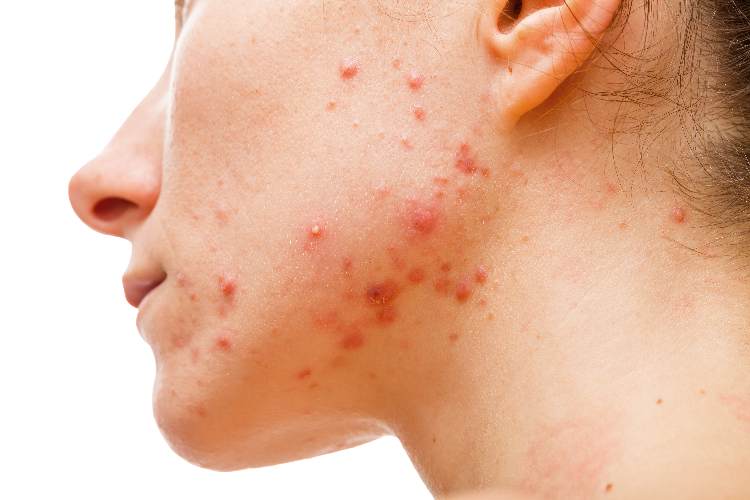
Skin care products such as medicated creams and lotions and cleansers can reduce secretion of sebum, alleviate inflammation, and unclog pores in case of mild or moderate acne.
People with severe acne may require prescription of acne medication to control hormonal imbalance.
Scars
Scarring is another major cause of blemishes. Scars are caused by excessive collagen accumulation after an injury (2).
They range widely in size, texture, and color.
Even though most scars resolve on their own, chemical peels, skin oils, products containing vitamin C and dermabrasion can help the skin heal quickly (3). Keloid scars are an exception; they continue to expand even after the skin has healed, and don’t respond well to therapy.
Cryosurgery and corticosteroid injections have proved helpful in this regard (4).
Birthmarks
Blemishes are flat patches of discolored patches that are present at birth or appear when a person is very young. These kinds of blemishes are called birthmarks (5).
They vary greatly in size and are usually brown or black.
Moles are brown or black and port wine stains and stork bites are red.
They are mostly benign and are caused by hyper pigmentation in one area of skin or by blood vessels being located too close to the skin. As they are generally just a cosmetic problem, they can easily be treated with laser therapy or steroids.
Some common types of birthmarks include (5):
- Moles: These are black or brownish black spots that usually appear on the skin at birth. Mostly, moles are benign and not a cause for concern. However, any changes in size or color of moles are a danger signal of melanoma.
- Mongolian spots: These are bluish patches that develop on the skin of infants and small children, usually those of Asian descent. They are benign and disappear over time.
- Port-wine stains: These are flat, reddish or pink patches. They appear duet o swelling of blood vessels under the skin.
Uneven skin tone
An uneven skin tone with blotches over the face is also a type of blemish. It is caused by over production of melanin pigment (hyper pigmentation). As melanin secretion depends on hormones, sun exposure and skin injury, an excess of any of these things can cause uneven skin tone.
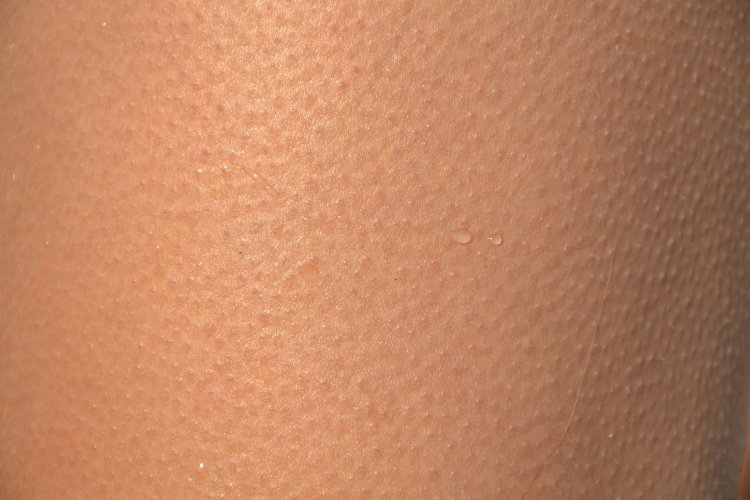
Treatment depends on the type of discoloration and the causative factor. Uneven skin tone is usually treated by topical creams, exfoliation, and medication to regulate hormones (6).
Liver spots
"Liver spots" (solar lentiginosis) are also known as lentigos.
These sun-induced pigmented lesions are brownish flat spots on the skin.
They have nothing to do with liver function. They are, in fact, signs of aging (7).
The hyper pigmentation may be triggered by over exposure to sun or exposure to ultraviolet light or other unknown causes. They are most visible on the hands and face and tend to increase in size and darken over time.
The severity and extent of liver spots are determined by sun exposure, skin type, and age.
Liver spots are mostly benign, but can easily be confused with lentigo maligna, which is an early sign of skin cancer.
Many people do not opt for a treatment of liver spots because they are an inevitable result of aging, although in some individual their appearance causes a lot of distress.
Treatment options may include the following:
- Chemical peel: Tretinoin (Retin A) is used on its own or it is combined with mequinol (Solage). Tretinoin is a derivative of vitamin A and is also beneficial for treating wrinkles on the skin.
- Cryotherapy: This means gentle freezing with liquid nitrogen.
- Laser treatment: Laser therapy is a popular option for treating liver spots because about 80% liver spots can be removed in one visit. Laser treatment is much more effective than cryotherapy and has fewer side effects.
- Bleaching creams are easily available and are an economical option but they are not as effective as chemical peels. Plus, they can cause permanent discoloration of the skin.
Purpura
Blemishes due to purpura appear when small capillaries break and blood leaks under the skin (8). In older people, purpura occurs due to the fragility of blood vessels. The blood vessels appear as red purplish flat patches. When these patches are smaller than 3 mm, they are called petechiae. When they are larger than 3 mm, they are known as ecchymoses. Patients usually have a rash at first, which eventually changes to brownish color or purplish red color. Even there is no fixed treatment for purpura, patients are advised to prevent any kind of trauma to the skin, such as forceful rubbing of the skin, which may harm the blood vessels. Emollient creams that soften the skin are also helpful in this regard. Some doctors also recommend the use of vitamin C supplements.
Seborrheic keratoses
This skin condition is commonly observed in older adults (9). Its cause is yet to be determined. They are most conspicuous in the neck, head or trunk and may in size from 0.2 - 3 cm. Their shape is well defined and they appear to be glued onto the skin. Their appearance varies greatly:
- They sometimes have a smooth surface with small, spherical, pearl-like whitish molecules embedded in them.
- They may appear rough and like warts.
- They may be black or brown in color
Seborrheic keratoses are sometimes confused with melanoma when these blemishes have an irregular border. They are always benign. A skin specialist can tell the difference between the two, even though dermatologists warn that melanomas may be present under these benign blemishes and go unnoticed without careful inspection.
Mostly, seborrheic keratoses have a well-defined appearance, whereas melanomas usually have a smooth surface that differs in shape, height, size and color density. In some people, keratoses may cause discomfort and itching.
Seborrheic keratoses can be removed by surgery or by freezing. Vitamin D3 ointment is also known to be effective.
Skin discoloration
The majority of cases of skin discoloration are a result of trauma, injury, and inflammatory disorders (10). Discolored skin patches also appear due to the difference in melanin levels across different parts of the body. Melanin is the pigment that gives skin its color and protects it from harmful sunrays. If there is over production in any area of skin, that patch of skin becomes discolored.
There are many possible reasons behind blemishes caused by discolored skin patches. These may be minor problems or serious medical conditions.
- Burns: Skin is sensitive and is easily damaged when exposed to harsh sunlight or heat. Sunburns appear as discolored skin. Discolored skin patches may also appear when you apply sun block in an uneven manner, resulting in different areas of your skin getting tanned. Some medicines may also increase the sensitivity of skin, causing it to turn red.
- Infections: Infectious diseases can cause skin discoloration. Bruises and open wounds or scrapes can become infected when germs enter them. This brings about changes in the texture and appearance of the skin, turning the surrounding skin white or red. Fungal infections, for example, tinea versicolor and ringworm, may also cause discoloration of the skin and development of blemishes.
- Autoimmune disorders and allergies: Our immune system works to protect the body from germs by fighting off harmful disease causing agents. However in patients suffering from autoimmune disorders and allergies, the immune system attacks the body cells. This triggers inflammation in the human body and causes skin discoloration and redness. Some immune system diseases, for example, Graves’ disease and lupus erythematosus, may trigger skin reactions. These reactions may be the development of red rashes and blisters to skin discoloration. Also exposure to allergens and irritants triggers an allergic reaction, which may lead to skin discoloration. The discolored area may appear as reddish rashes or bumps that burn and itch. One common allergic skin reaction that can trigger skin discoloration is eczema. As in some autoimmune disorders, eczema triggers an immune reaction that affects the skin. Discolored scaly patches or bumps may erupt over the skin that later turn into blemishes.
- Hormonal fluctuation: Changes in hormone levels, particularly in pregnant women and during puberty, can trigger discoloration of the skin. This discoloration often takes place due to raised levels of the female hormones progesterone and estrogen.
Skin cancer
Skin cancer can alter the skin’s texture and color and cause blemishes. Skin cancer develops when the structure of skin cells is damaged due to long- term exposure to sun or harmful chemicals. There is an uncontrolled multiplication of skin cells. There are many types of skin cancer and all require medical attention. Mostly, discolored skin patches and blemishes aren’t a symptom of skin cancer. But still, you should consult your doctor and ask him to examine any irregular moles or other abnormal changes in the skin.
Overview of other common causes of blemishes
There are many different factors that contribute towards the appearance of blemishes. Most commonly they are caused by irregular hormonal activity. Raised levels of some hormones such as estrogen can over stimulate the skin sebaceous glands, causing them to secrete extra amounts of sebum. A mixture of sebum, dirt, germs and dead cells clogs up skin pores and causes development of blemishes such as pimples, pustules, blackheads, and whiteheads. There are other causative factors too besides hormonal imbalance.
Some of the most common factors that cause blemishes are:
Age
As we age, our body goes through many changes and unfortunately, not all of them are good.
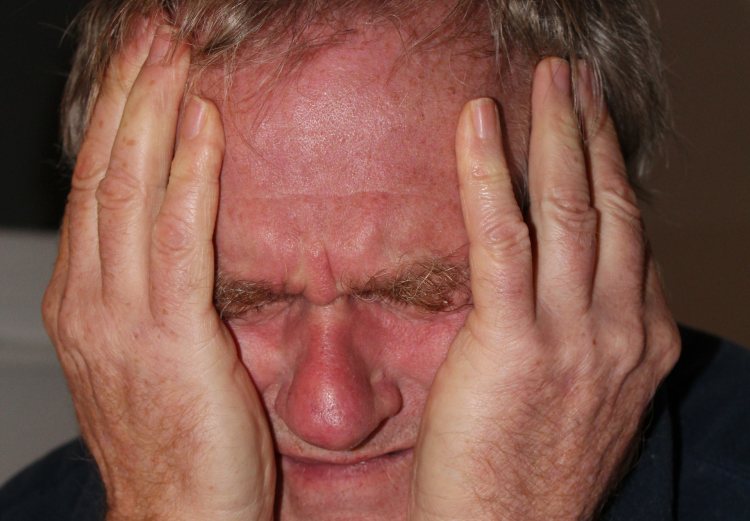
As the health of certain organs is adversely affected, the skin also undergoes changes. Visible symptoms of aging may be evident as discoloration or appearance of dark spots on the skin. A lot of people observe darkening of different areas of skin.
Exposure to sun
Too much exposure to harsh sun rays can cause over production of melanin and discoloration of the skin. The ultraviolet rays present in sunlight can inflict a considerable amount of damage on the skin, which could lead to tanning and darkening of the skin and development of blemishes.
Cosmetics
If skin is not cleansed properly after using cosmetics, they can block skin pores and cause acne and blackheads.
Chemicals
Exposure of skin to harmful chemicals, especially when they are present in the environment around us, can cause significant damage to skin. These chemicals can also cause discoloration of the skin and uneven skin tone. It is not only the chemicals in the environment that cause blemishes, but also chemicals present in makeup products, aerosols, cleaning materials, etc.
Genetic factors
Genetics also plays a part in causing blemishes. Individuals having parents prone to this skin problem have a higher tendency of developing blemishes on the skin.
Foods
Some skin specialists say that food items such as chocolate could also lead to acne and blemishes on the skin.

There are no clinical studies at present to prove this claim though.
Symptoms of blemishes
In most cases, a blemish is a symptom itself of an allergy, immune disorder or serious medical condition.
Some common symptoms associated with blemishes include:
- The eruption of pus - filled bumps or elevations, usually on the facial area.
- The appearance of painful and inflamed pustules.
- Discoloration of skin and uneven skin tone.
- Reddish or brown patches that appear on the surface of skin.
- Changes in texture of skin, from smooth to warty and rough.
- Dryness, inflammation, and itching in affected skin area.
All these symptoms may not appear in case of a blemish. Only some people experience all these symptoms, most individuals have uneven skin tone, scarring or acne marks.
How to get rid of blemishes?
Prevention & lifestyle changes
Even though it is impossible to prevent some forms of blemishes such as birthmarks and effects of aging, the risks of acquiring other types of blemishes such as pimples and pustules can be significantly lowered through vigilant skin care. Applying sun block and avoiding exposure to sunlight and harmful chemicals can help prevent blemishes and uneven skin tone (11). Staying hydrated can help maintain the health of the skin. Washing your face properly on a daily basis with a cleanser that is suitable for your skin type is also important, as is applying a good moisturizer. Besides this, using breathable bandages, proper wound care, and anti-scarring cream can all decrease the chances of developing blemishes.
Prevention is better than cure
The best way to get rid of blemishes is prevention. If you want to stay blemish free for as long as possible to ensure that they not appear in the first place. Start treating blackheads, pimples, pustules and whiteheads as soon as they appear. Do not pop zits or pimples or try to extract whiteheads or blackheads forcefully.
Day to day skin care
Maintain skin hygiene and wash your face daily with a cleanser suitable for your skin type which is good for cleaning up excess sebum, dirt, and oil. Avoid use of harsh skin products or cleansing agents as they irritate the skin even more.
Avoid too much of sun exposure
Sun rays aggravate acne and cause blemishes and dark spots. To shield your skin from damage from the sun, apply a good amount of sun block with at least SPF 15 on exposed parts of your skin before you step out into the harsh sunlight.
Calamine lotion
Gently rub calamine lotion onto your face or wherever blemishes have appeared on your skin (12). Calamine lotion helps in drying up excess oil and sebum from the skin and thus effectively removes blemishes. Apply calamine lotion regularly on a daily basis.
Ice compressing
Take a chunk of ice and wrap it in a clean towel or cloth. Apply the wrapped ice on the skin blemishes for a few minutes. This process will soothe the skin blemishes and decrease inflammation. Use this remedy as soon as a blemish is visible to get rid of inflammation and redness.
Drink water
Increase intake of fluids and make sure that you drink enough water to stay adequately hydrated throughout the day.
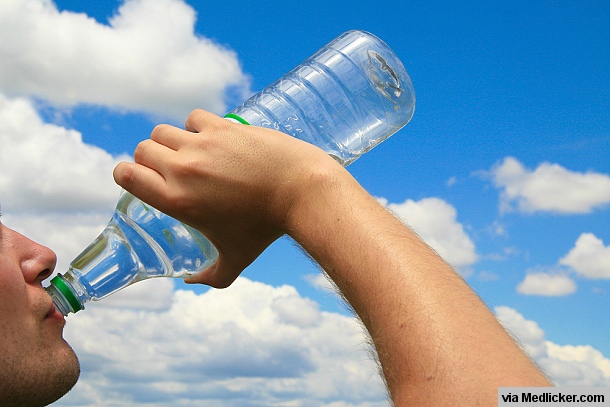
Water will help to detoxify and cleanse your system. It will keep acne at bay by flushing out toxins. It will also give you a radiant and clear skin.
Eat a good diet
Make sure that you take a healthy, well- balanced diet. You should eat plenty of fresh fruits and green, leafy vegetables, which bring out a radiant glow on your face. A healthy diet will slow down aging process of skin and brighten your overall complexion and make blemishes appear less visible.
Over-the-counter creams and lotions
Opt for over the counter creams and lotions to treat blemishes and skin discoloration unrelated to acne. In cases like mild sunburn or moderate skin trauma, skin will return to normal once the injury heals. It is important to keep your skin moisturized while the skin heals. Some skin care products can also be used as a cosmetic cover - up to hide blemishes and marks.
Prescription medication
Usually, blemishes disappear after a while but stubborn and persistent facial blemishes (such as the ones on chin or eyelids) caused by acne have to be treated with prescription medicine. Your dermatologist may prescribe an oral medicine, topical lotion, and cream or both to treat your blemishes (13, 14).
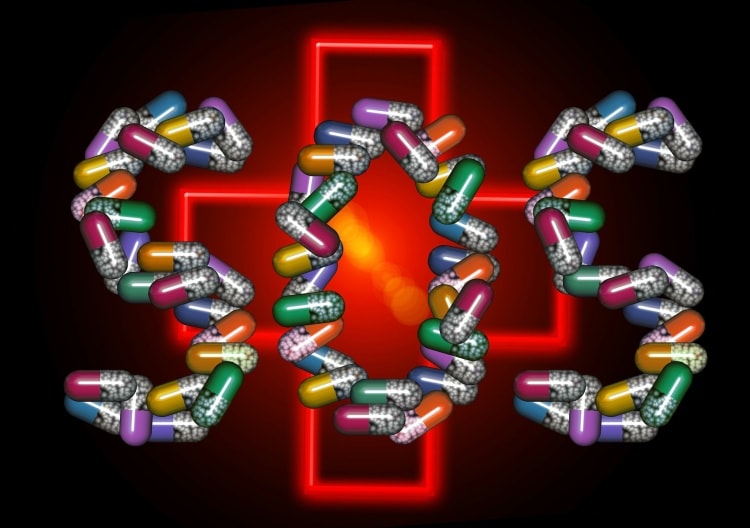
According to the American Academy of Dermatology, there is no quick cure for acne blemishes. You must be patient and continue with your treatment regimen. It will take at least four to six weeks before you will notice any improvement. Some acne medicines have been known to cause birth defects. If you are pregnant or plan to become pregnant, inform your doctor and take his advice before starting a treatment regimen.
Laser resurfacing
In laser resurfacing, your dermatologist will remove the top layer of skin of your facial area to exfoliate your skin (15). This stimulates the cells under the top layer to secrete collagen, which gives your skin a radiant glow in addition and evens out your skin tone (15). According to a research conducted by the University of Michigan Health System, laser resurfacing is a good treatment course if blemishes are produced due to aging or sun damage (16). Duration of treatment depends on the severity of skin damage and how much time it takes to remove the discoloration of skin.
Surgery
For severe blemishes and scars, doctors may recommend surgery. Blemishes that are rough, warty, flat, infected, or red or brown in color should be examined by a skin specialist immediately, as these are common danger signs of skin cancer. The Siteman Cancer Center in Washington Medicine School University cautions that skin cancer may develop in parts where other blemishes, such as pockmarks or burns, are already present. If your facial blemish displays any of the symptoms of skin cancer, your dermatologist may want to remove it as soon as possible through a surgical procedure.
Home remedies for blemishes
Lemon juice
Lemon juice works wonders when it comes to treating blemishes and hyper pigmentation (16, 17).
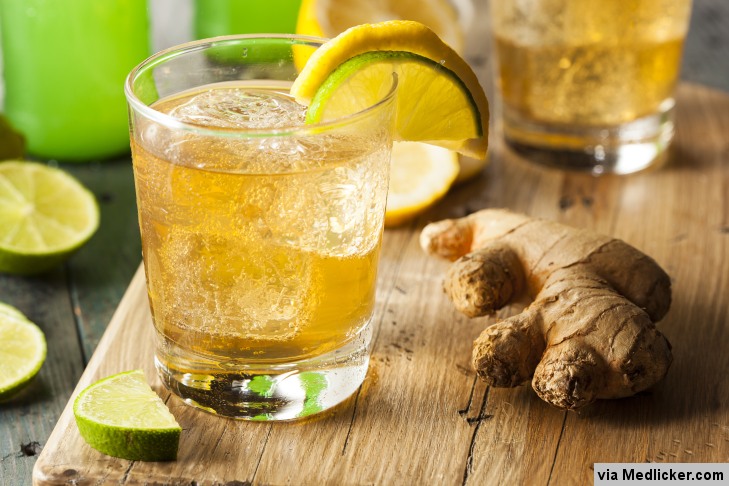
Simply rub a wedge of lemon on your skin.
You can also extract the juice and apply the juice over affected area using cotton.
Lemon juice acts as a bleaching agent and lightens dark spots and blemishes. It also brightens the color of skin.
Gram flour and turmeric
This home remedy has been in use since ancient times to treat various skin related ailments and to improve the cosmetic appearance of skin.
Just take two full tablespoons of gram flour and combine it with some yogurt, lemon juice and a pinch of turmeric powder.
Apply this thick paste on your skin and allow it to dry for about fifteen minutes.
Then rinse it off with clean water. Your skin will turn soft, clear and smooth. Repeat this process for a few months to make blemishes disappear.
Potato, honey, and lemon juice
Purchase some potatoes from your nearby market, grate them and extract their juice.
Add a teaspoon of honey and some lemon juice to this potato juice.
Apply this mixture all over the affected area.
Your skin will be smooth and clear.
To get rid of tanned skin and hyper pigmentation, apply over areas with uneven skin tone and dark spots.
Tomatoes
Tomatoes are loaded with antioxidants and vitamin C which makes them one of the most effective remedies for blemish removal. If used on a regular basis, tomatoes can also improve your skin tone and complexion. In addition, application of tomato juice also helps in shrinkage of large pores and prevents break out of acne and pimples. Tomatoes have high lycopene content which makes them a good option for removal of sun tan and blemishes.
Extract the juice or take pulp of tomatoes and combine it with some lemon juice. Store and refrigerate this tomato-lemon juice mixture. Apply this cleanser on your face two times a day using cotton. It will not only remove blemishes but also help to reduce dark spots.
Honey, lemon, and turmeric
Take a teaspoon of turmeric powder and mix it with liberal amounts of lemon juice and honey.
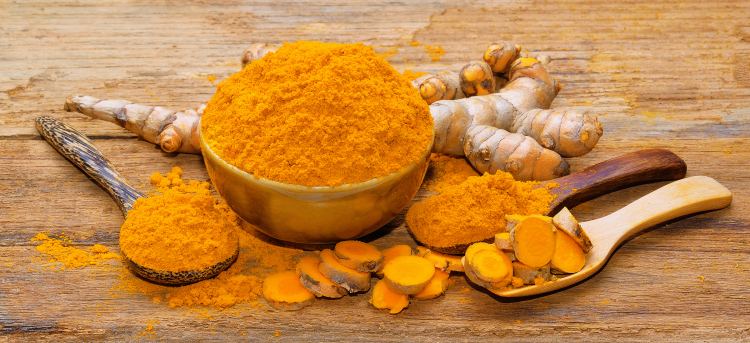
Apply this evenly over the facial area. This is an excellent home remedy for removing blemishes and unsightly pockmarks on skin.
Sandalwood and rose water
Rose water and sandalwood paste is a very good remedy for removal of blemishes and dark spots. Prepare a paste of rose water and sandalwood and rub this onto your skin. Allow it to dry for some time and then rinse it off using clean water. It helps to remove pimples and improves complexion of skin.
Neem water
Take a handful of fresh neem leaves and soak them in water overnight. Wash the affected skin area especially face with this neem water every day. This will help prevent the formation of blackheads, pimples, and pustules on face. A paste of neem leaves can also be used which has excellent medicinal properties (19).
Reduce blemishes with almonds and milk
Almonds have rich content of vitamin E and work as a great skin care remedy. Milk contains lactic acid that helps in removing scars and brightening skin tone.
Directions
Soak about seven-eight almonds in water for ten hours or more. Peel off the skin of almonds, crush them and mix them with a teaspoon of milk to prepare a paste. Apply this paste to your face especially over blemishes and marks. It’s better if you leave it on overnight. Wash it off the next morning.
Almonds can be used in other ways as well. Using your fingertips, massage almond oil on your face and neck in circular motion. Leave it on for fifteen to twenty minutes and then clean off extra oil using wet wipes. Repeat this process at least once daily to get best results.
Use mint leaves to reduce scars
Mint leaves are an excellent ingredient for removal of blemishes. They remove acne by drying up excess sebum and oil and by unclogging the pores. Application of mint leaves paste clears up marks and blemishes and improves skin complexion. Here is how you can use mint leaves for removal of skin blemishes:
Take a handful of clean mint leaves. Purchase them from your local grocer or pluck them from your herb garden. Crush and grind them and mix them with some water to prepare a paste. Apply this paste on marks and blemishes. Let the paste dry for fifteen to twenty minutes. After it dries, wash it off with clean water.
The peels of lemon and orange
Peel off orange and lemon skins and allow them to dry in sunlight.
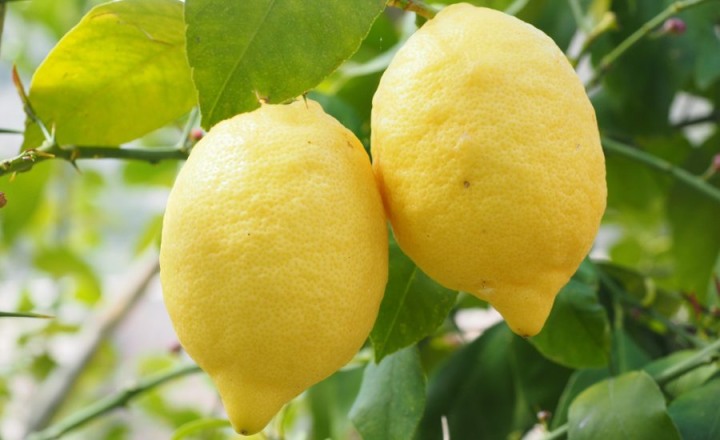
After that, grind them into a fine powder. Prepare a paste with this powder using rosewater or yogurt. Apply this mask on face. It will improve skin tone and remove blemishes and scar marks.
Honey and milk
Use a mask of pure milk and honey to cleanse your face. It helps in minimizing the appearance of blemishes and unclogs pores.
Tea tree oil
This is a brilliant home remedy for the treatment of blemishes caused by acne (20). Buy good quality tea tree oil from a well- reputed company. Apply the tea tree oil directly onto the blemishes on the face or combine it with other ingredients in the form of a face pack. Use it carefully if you have sensitive skin. Dilute it first in water to reduce its potency.
Green gram
Grind some green grams into a coarse powder and prepare a paste of it with water. Gently apply this paste over your blemishes and facial area to remove marks and uneven skin tone.
Cinnamon and honey mask
Make a face mask using cinnamon and honey.
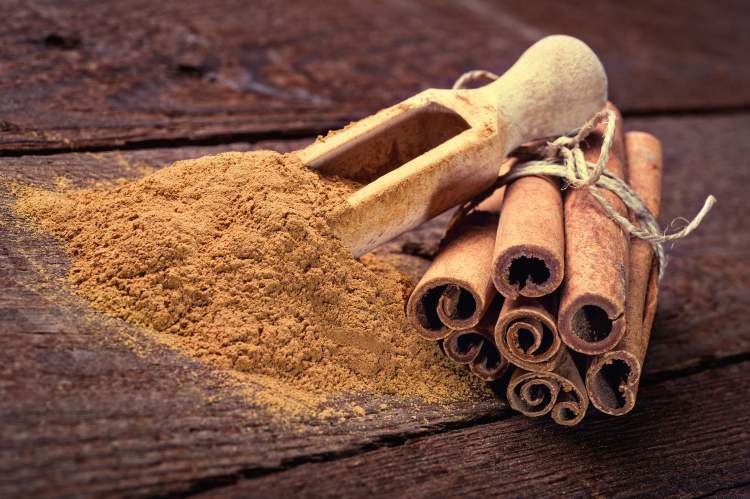
Apply it over affected area and allow it to dry. After that, wash it off completely using clean water. Follow this up with a suitable moisturizer to prevent your skin from drying out. Your skin will soon acquire a soft, rosy glow and blemishes will gradually disappear.
Green tea
Brew a cup of green tea, allow it to cool and use it to wash your face. Repeat this process daily. This process is beneficial for preventing blemishes and pimples.
Apples and honey
Wash and mash some apples. Mix mashed up apples with honey.
Apply this mashed apple and honey mixture on your face to treat blemishes and pimples. Repeat this process twice or thrice a week for optimal results.
Use egg whites
Egg whites are an easy and economical remedy to help reduce blemishes and scars left by stubborn acne (21). The reason why egg whites have been found helpful for skin is because they’re rich in vitamins and proteins that both ward off acne, and help to rejuvenate your skin cells. They also absorb up excess sebum and oil, which significantly reduces chances of blemishes or pimples making an appearance. Just be careful to use a good moisturizer afterward as they may dry up your skin.
You need:
Three egg whites separated from yolks.
- A large bowl.
- A whisk.
- A clean, soft cloth.
Instructions:
Wash your face properly with water and dry it. Separate the whites of eggs from the yolks. You can use as many as needed, but usually, two to three are adequate. Whip up the whites with a whisk until they become frothy, and allow them to sit for a few minutes. Apply the whisked egg whites on your face like a mask focusing on affected areas. Four layers are usually enough, but let the first one dry before adding another layer on top of it. Let the mask sit and dry for about half an hour before washing it off entirely with lukewarm water and a patting your skin gently dry with a clean cloth. Afterward, apply a moisturizer suitable for your skin type.
Try some apple cider vinegar
Apple cider vinegar is an excellent choice for removing blemishes. It is bactericidal and eliminates acne causing germs (22). It also becomes alkaline and neutralizes pH of the skin, making it harder for bacteria to survive. A bonus point is that it’s an astringent and absorbs excess oil from skin.
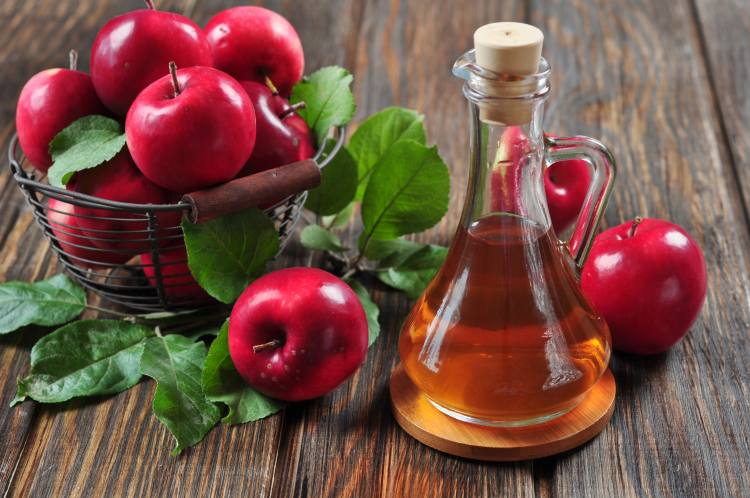
Go light on its use though and don’t overdo it as it might dry up your skin. This could stimulate the sebaceous glands to produce extra sebum to compensate, thus triggering a breakout.
Things you will need are:
- Pure, good quality apple cider vinegar
- Filtered water
Directions
Wash your face with water and gently dry it. Keeping a proportion of 1 part vinegar to 3 parts water, dip cotton into vinegar and apply it directly to the marks or blemishes. Leave it on fro about twenty minutes. Repeat this process whenever you wash your face. Do use a moisturizer afterward if you feel like your skin has dried up too much.
Papaya for the pimple prone
Papaya is an important ingredient used in a lot of beauty products available in the market, but you can gain its benefits at home. Plain raw papaya is a great skin conditioner that removes excess lipids, oil, and sebum from skin giving it a smooth, soft look. An enzyme called papain is present in papaya, which alleviates inflammation and prevents the formation of pus.
Instructions
Wash your face properly with water and pat dry with a soft towel. Mash up the flesh of a large papaya with a spoon until it forms a paste. Apply the papaya pulp mask over your face and allow it to sit for half an hour and then rinse it off. If your dries up quickly, apply a moisturizer suitable for your skin type afterward.
Aloe vera for blemishes
Aloe vera gel can be used with other ingredients to treat blemishes and acne, but it’s an effective skin remedy on its own as well. Aloe vera is extremely soothing and it works as an anti-inflammatory agent by reducing irritation and swelling (23).
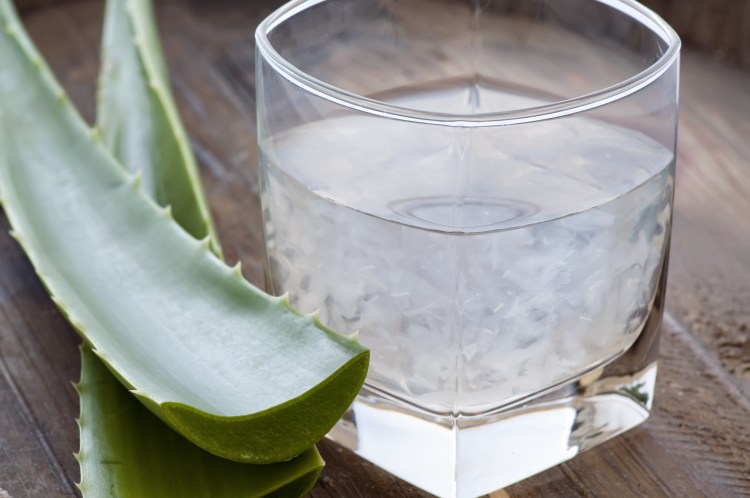
It also has antibacterial traits. It is wise to grow some aloe vera in your garden or keep a potted plant of it in your house.
Directions:
Wash your face with water and dry it with a washcloth. Using cotton, a Q-tip or your fingertips, rub the aloe vera gel directly onto your spots and blemishes.
Place three fresh strawberries in a bowl and mash them with a fork. Pour vinegar into the bowl and mix it with the mashed strawberries to prepare a paste. Apply this strawberry and vinegar mask on your face, especially on blemishes. Leave this mask on overnight. Place a towel between your face and pillows to keep your bed sheet and pillow clean. Wash it off in the morning. Put this paste on every night. It can be used not only to treat blemishes but to prevent them as well.
All of the above mentioned remedies are beneficial for the treatment of blemishes and acne scars. You can easily prepare these natural remedies at home without any hassle.
But remember that you always need to see your doctor before attempting to treat your blemishes! Self treatment may be dangerous!
Precautions
Do not start taking any prescription medicine without consulting your dermatologist first as it may cause more harm than good.
Inform your doctor about your complete medical and drug history.
Avoid exposing skin to the sun after receiving laser therapy. The area being treated should not be exposed to sunlight. Ultraviolet rays irritate the area more and turn it red, so step out in sun after applying sun block of at least SPF 30 and cover affected area properly. The skin area after receiving skin laser takes some time to heal so handle it gently. Do not scratch, rub or prick it. If you get laser treatment of facial area, do not use harsh scrubs or cleansers and don’t shave.
If you apply a home remedy that dries up your skin, make sure to use a moisturizer afterward or it will trigger further acne and pimples.
FAQs about blemishes
When should I see a doctor?
Blemishes usually disappear after a while. They can also be easily covered up with makeup and foundation. But if they persist and expand in size, consult a dermatologist. For stubborn acne, you will require proper medical treatment. You might also require medicine to regulate hormone levels.
How to differentiate between blemishes and melanoma?
If you are worried about your blemishes, have them examined by a skin specialist to check if they are benign or malignant. Consult a doctor immediately if you notice changes in size, color or shape of a birthmark or mole.
Things to remember
Blemishes usually disappear on their own so do not stress out as stress leads to further break outs. However, if they cause pain and discomfort contact a dermatologist.
Laser therapy, chemical peels, over the counter creams and lotions, etc. are used to treat blemishes.
Blemishes can be treated by using many home remedies as well such a lemon juice, turmeric powder, honey, apple cider vinegar, apples, etc. Home remedies are all natural and do not cause any side effects.
| Written by: | Michal Vilímovský (EN) |
|---|---|
| Education: | Physician |
| Article resources: | See numbered references within the article. |
| Image resources: | Adobe Stock and Pixabay |
| Published: | July 20, 2016 at 7:04 AM |
| Next scheduled update: | July 20, 2018 at 7:04 AM |
Get more articles like this in your inbox
Sign up for our daily mail and get the best evidence based health, nutrition and beauty articles on the web.

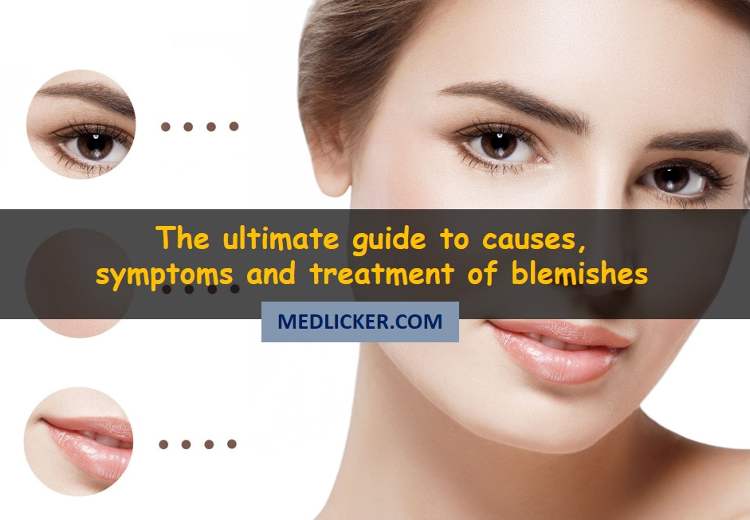
Ache in left arm that you should not ignore
Alkaline water dangers: why you should not drink it
How to Avoid Sleepiness While Studying?
23 Foods That Increase Leptin Sensitivity
Low dopamine (e.g. dopamine deficiency): causes, symptoms, diagnosis and treatment options
Swollen taste buds: the ultimate guide to causes, symptoms and treatment
Thin endometrial lining: causes, symptoms, diagnosis and treatment
Pimples inside nose: the complete guide
Holes in tonsils: definition, symptoms, treatment and prevention
How to deal with an ingrown hair cyst
Allegra vs. Zyrtec vs. Claritin
Allergy to penicillin and alternative antibiotics
How to get rid of phlegm (excessive mucus) in throat? Detailed guide to medical and home remedies, symptoms and causes
What causes stomach ache after meals?
Liver blood test results explained